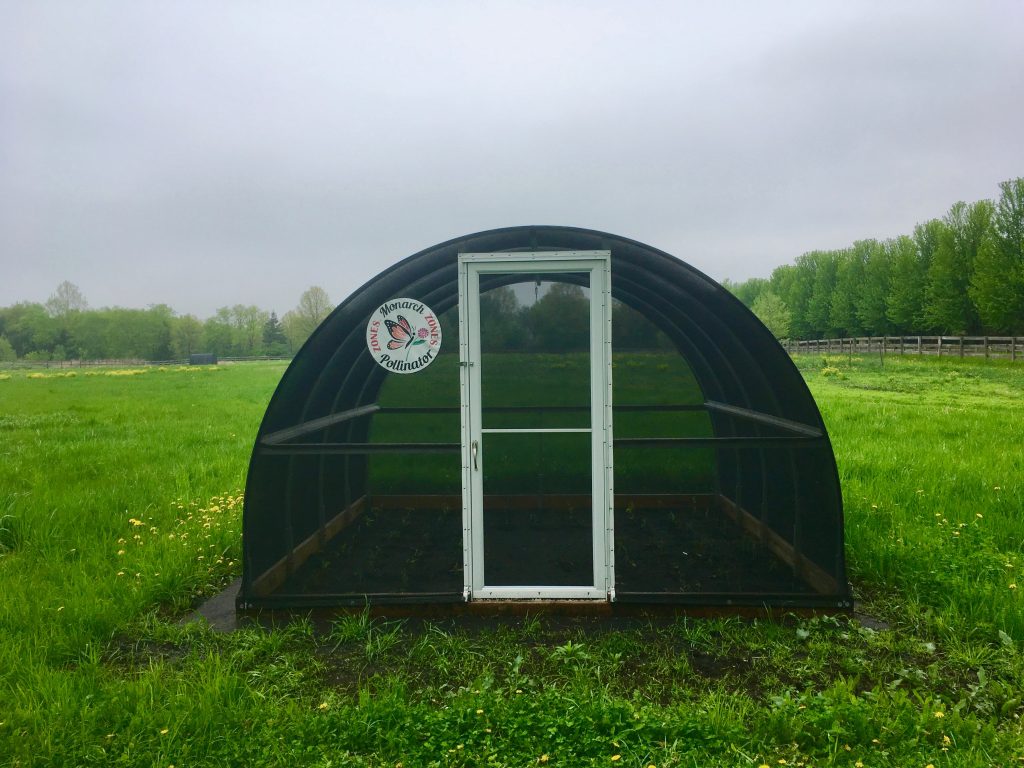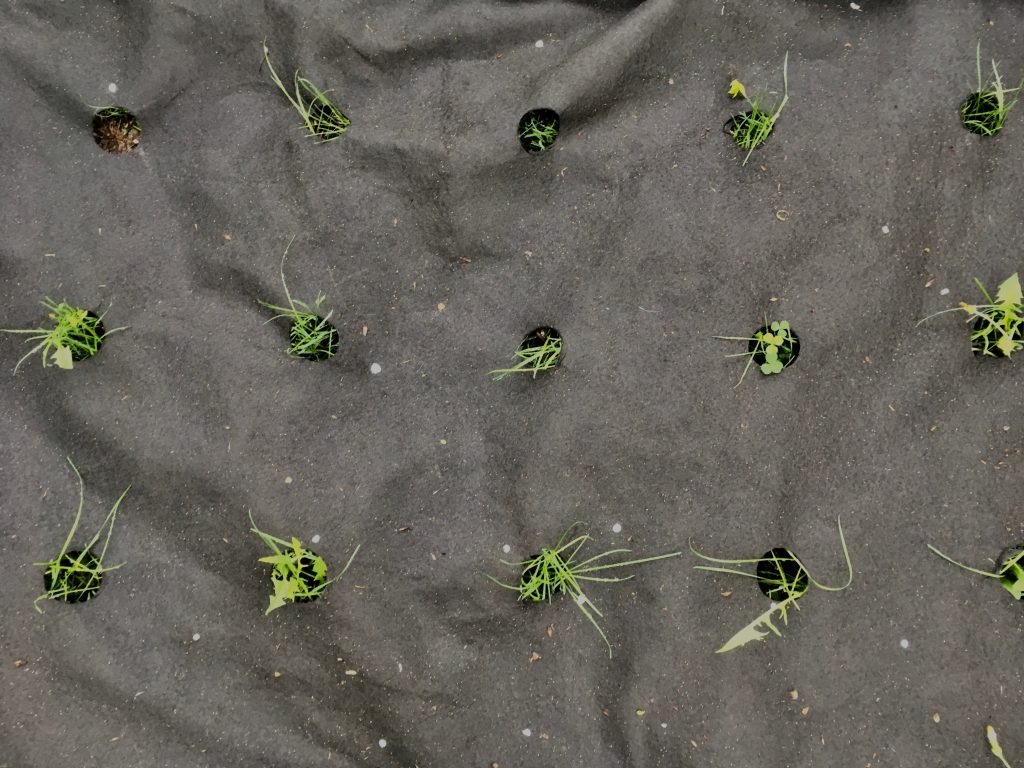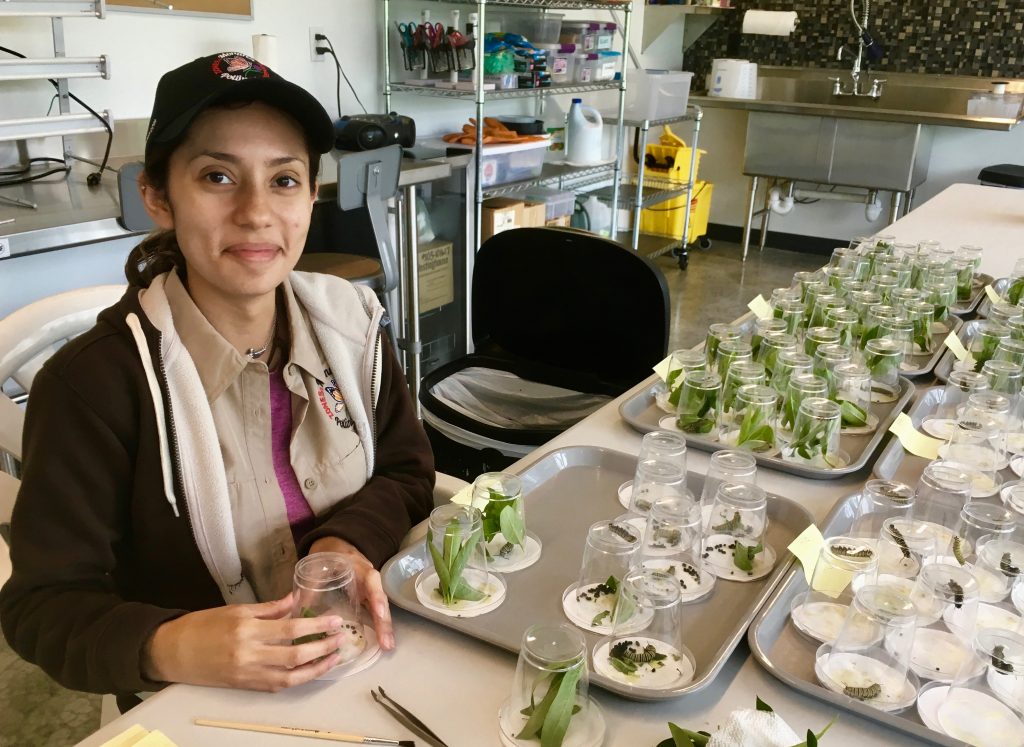MARION, IOWA–Hundreds of fourth and fifth instar monarch caterpillars have replaced prize-winning show horses as the preferred livestock at Clearwater Farm in Linn County, Iowa. The hungry creatures nosh on common milkweed in a mesh enclosure inside the barn’s lab area. In the back, where dressage halters and fancy saddles once occupied the storage area, shovels and hoes, hundreds of plant pots, and stacks of boxes fill the stable’s tidied up stalls. Known for the clear blue waters of its manmade ponds, the former thoroughbred horse breeding facility now houses the Monarch Research Project (MRP), a small nonprofit organization driven by a mission to help save the monarch butterfly migration.

Monarch Zones Biotent: a solution to monarch butterfly population declines? –Photo by Monika Maeckle
The MRP’s signature program: Monarch Zones, a program that crowdsources the raising of monarch butterflies to the local community by providing everything needed to raise them in trademarked BioTents. The fostered livestock is released to the skies, hopefully increasing the number of migrating monarch butterflies. MRP claims to have raised and released 30,000 monarch butterflies in the last two years.
Participants purchase special rearing enclosures from Monarch Zones (MZ). The MZs include access to free milkweed plugs, monarch butterfly eggs, caterpillars–even gravid females for laying future eggs. MRP also provides a User Manual filled with 39 pages of how-to information on raising the butterflies.
“As a Monarch Zone you will raise monarch stock for 30 days, releasing them after completion of MZ protocols,” reads the welcome card and member agreement that accompanies MZ membership. To date, MRP has placed 141 of the pop-up enclosures, which sell for $230 – $417, depending on their size.
Michael Martin, Research Station Manager who oversees MZ day-to-day operations, explains what he calls a “one and done” approach to “rearing monarch butterflies on the wild side” during a recent tour of the facility.

Monarch Zone kit includes landscape cloth precut with holes for milkweed plugs. Photo by Monika Maeckle
First, identify a suitable location for your Monarch Zone. Cover the space with landscape cloth that comes with your MZ kit–the precut holes in its fabric allow for easy planting. Install milkweed plugs in the holes. Place the BioTent over the milkweed-planted landscape cloth, add monarch butterfly livestock to the enclosure, zip up the door and walk away.
“You can close it up and never have to go in again until you see butterflies flying,” says Martin, a Master Gardener and professional landscaper who worked for years at nearby Kirkwood Community College. The specially selected mesh allows rain or supplemental water into the enclosure without even unzipping the door. Ample airflow keeps the insects healthy, and the enclosure keeps out predators like birds, wasps, tachinid flies and possibly diseased wild butterflies.
Monarch Zones began in 2014 at the former thoroughbred horse farm owned by Clark and Marian McLeod in Marion, Iowa, near Cedar Rapids. The 80-acre spread sits in the heart of the monarch butterfly summer breeding grounds.

Michael Martin, Research Station Manager, at the Monarch Research Project in Marion, Iowa. Photo by Monika Maeckle
Clark McLeod says he was taking a lesson from his tennis coach Cam Watts when Watts introduced him to the magic of monarch butterflies. The former science teacher had been raising the insects for years. After McCleod learned the story of the monarch migration and its recent decline, he decided to apply his energies and resources to the task. “The monarch is magical, it pulls you into the conundrum,” says McLeod.
Perhaps best known for his career as a self-made billionaire telecom executive whose company MCLeodUSA became the subject of multiple lawsuits in the mid 2000s when it went bankrupt, McLeod has a history of thinking big. He says he likes to apply business principles “to problems that people are dancing around.”
Monarch Zones is just the pilot for what he envisions as a three-pronged, national program to help save the monarch migration. He describes the MRP’s goals as “moonshots,” a term typically used to describe a bold, exploratory or groundbreaking approach that sometimes includes an incomplete understanding of potential risks and/or benefits.
Moonshot 1, says McLeod, is to replace the population in Linn County, Iowa, by creating Monarch Zones. McLeod favors focusing on a specific geographic area during this pilot period. Moonshot 2 aims to create 10,000 acres of habitat in Linn County by partnering with cities and counties, private landowners and public land managers. And Moonshot 3, hopes to qualify and quantify the success of the project into a “playbook” to be shared nationwide for “Zones across America.”

Intern Michelle Mattes feeds monarch caterpillars common milkweed. Photo by Monika Maeckle
“I think ‘moonshot’ is an apt descriptor,” observes Anurag Agrawal, PhD in chemical ecology and author of Milkweed and Monarchs. Agrawal says he is bothered by the audacity of the approach and compares the systematic introduction of captive bred monarchs into the wild to “ladling water out of a sinking ship.”
“Sorry to be negative…It’s a losing battle,” he says. “Adding these drops in the bucket won’t save the migration, species, or our planet. It will make some of us feel good, and we might learn some butterfly biology along the way. Both are good, but they are not sufficient. I worry that such approaches contribute both to plausible deniability about our environmental problems and to our superiority complex as a species.”
Sonia Altizer, one of the foremost experts on monarch diseases, especially the monarch-centric, spore-driven Ophryocystis elektroscirrha, commonly known as OE, also has concerns.
“How do we know the monarchs are healthy and disease free?” asks Altizer. Despite constant vigilance and sterile procedures at the lab she oversees at the Odum School of Ecology at the University of Georgia, she says even small lapses in screening (missing one infected monarch) can lead to a disease outbreak–and not just OE. “Every few years in my lab we have catastrophic larval and pupal mortality due to non-OE causes – and that’s even when rearing monarchs singly with clean plants, sterile containers, etc.”
Martin contends MRP abides by best practices developed by commercial butterfly breeders. He and Watts have attended workshops staged by the International Butterfly Breeders Association and the Association for Butterflies to learn procedures and protocols. Breeding stock are tested for OE and milkweed leaves are triple washed in a 5% bleach solution and dried in a salad spinner before feeding to caterpillars. A recent tour required stepping into a tub of bleach solution before entering the caterpillar rearing area as a safeguard. Martin says MRP also limits the number of eggs and/or caterpillars supplied per BioTent to 34–typically one per milkweed plant.
“We test for OE and have only had one case,” says Martin. “For us, it’s about rearing right along with nature, providing as natural an environment as you can get outside.”
The Monarch Zones experiment continues this summer. Milkweeds and BioTents have already been issued. Monarch eggs will be available June 9.
“We feel like we’re doing some good here,” says Martin. “We’re making a difference. If we don’t do something, then who? Coulda, shoulda, woulda–we don’t want to be caught saying that.”
TOP IMAGE: Fifth instar monarch caterpillars chow down on milkweed at the Monarch Research Project in Marion, Iowa. Photo by Monika Maeckle
Related posts:
- How to plan a successful butterfly garden
- Mostly native butterfly garden outperforms lawn every time
- A year in the life of an urban butterfly garden
- Downtown River walk plot converts to pollinator garden, creature haven
- Tropical Milkweed: To Plant it or Not is Not a Simple Question
- How to raise Eastern Swallowtails
- How to raise Monarch butterflies at home
Like what you’re reading? Don’t miss a single post from the Texas Butterfly Ranch. Sign up for email delivery, like us on Facebook, or follow us on Twitter, @monikam.


Great article Monika. Angrual needs to understand American ingenuity and will power a little better.
If 1 million people in Texas, Oklaloma , Louisiana and the summer breeding grounds and the Northeast each raise an average of 100 mnarchs in one batch, which almost eliminates the possibility of disease if Clean OE free monarchs and fresh clean pesticide milkweed is used,
Factor in the monarchs produced by their offspring, and the ones breeding and reproducing totally in the wild, the monarch population will soar to over 3/4 of a BILLION monarchs overwintering in Mexico.
Just The Beautiful Monarch Facebook page, and there’s lots more people than belong to that page, it’s membership increased to almost 20,000 citizen monarch breeders and releasers from around 10,000 in 2016.
There’s no reason that number shouldn’t double again this season.
if it happens that number puts us on the path to critical mass numbers of folks raising and releasing and 1 million participants becomes a small number.
At that point raising monarchs and other species takes on a life of it’s own and becomes a national pastime and hobby.
The future is bright. Americans have done things like this in the past so it’s no big deal. Cam, Mike, and Clark are doing a great job especially for those who have 6-700 $$$$ to invest in a hatchery and plants.
1) People who don’t have a thoroughbred horse farm or a million dollars $$$$$ can buy a small popup hatchery 15 x 15. X. 24 for under $10.
2)) if they add a pair of monarchs to the hatchery and put it in an east window inside their house to further eliminate predatorsi
3) and the monarchs breed and lay eggs which they will
4) and they change out the eaten plants and move the cats on them, they can raise 100 clean monarchs using 50 bushy plants for the reasonable expense of under $125 even if they spend $2 a plant for a 1 gallon milkweed.
5) if they raise their own 1 gallon milkweed plants they can do it for under $25. No biggie. We already have a great start. Let’s apply that great American spirit and make it happen.
P S. I’ll supply a the popup and plants Monika if you will give it a try. 🤔
Thank you Craig for your comment I guess some post need to be educated more, after reading the article which was very interesting I know that any little bit that we can do to help any species become healthier and Stronger in Numbers is a benefit no doubt about it or not doing anything at all and waiting for it to come to a point where nothing can be done at all. In Florida there is so much population that it said to see monarch and other butterflies hummingbirds try to find places of Refuge is extremely hard for them. Example Even as Florida being a fishing capital, with runoff of dirty rain runoff from the streets and homes fertilizer pesticide oil and with the Sugar Farms is major one there is so much crap going into our Waters that it’s causing a major red tide offshore along beaches inner Coastal ways that not only fish are dying but Dolphins manatee are dying people are even told not to even go into the water and not to eat the fish. So if we just let that go what do you think will happen nature needs our help anyway we can because we’re the ones that changed it in the first place. Alligators and bears walking in people’s yards eating trash bird seed going in swimming pools it’s sad we’re building on top of them and when that happens they are put down why for being Worthy should be. I’m sick of this going on. people need to get off their butt and do something. Well anyway I have my few pop up tents 12 x 12 15 x 15 two of them I try to do my part for the monarch and I plant beautiful flower beds for them and all butterflies hummingbirds and the bees because they’re really important to. Thank you!!!🐛🦋🐝🐞🐬🦈
There are few things I love more than American ingenuity. And I must admit, there is a lot of it! But, my main point is that if 1) safe passage to Mexico is what is currently lacking, 2) if intact overwintering grounds are no-longer, or 3) if pesticides threaten monarchs, then adding to the breeding pool while staying the course on 1, 2, & 3 will not end well for monarchs or our continent.
All my best, -Anurag
http://www.herbivory.com
MRP is creating a major Public Relations move in Eastern Central Iowa with the help of citizens who want to be a part of the monarch population revival. As a Monarch Watch volunteer, I’ve been coaching a Facebook group of over 1,100 people in the very same region for 4+ years on growing milkweed and best rearing practices; another group, Milkweed Matters is focused on providing thousands of milkweed seedballs throughout Iowa. I agree with Mr. Agrawal that the best solution is habitat restoration but I can’t imagine this farmland region returning to non-GMO crops so the other solution is restoring prairie in non-agricultural regions and support from the community. People who home-rear monarchs or provide milkweed in their yards are getting involved. Wouldn’t you agree that is a positive outcome and a possible solution for Mr. Agrawals problems #1,2,3? (Involved people can overturn environmental disaster – we removed DDT and saved the bald eagles.) I grew up in Marion, Iowa and in the 70’s it was a hotbed of monarch activity, caterpillars a-plenty.
Very interesting article! We have to keep in mind that nature is a balance.
This is just my opinion, but I don’t think “raising” monarchs is the right way to go about this. Among other things, monarchs aren’t even the only butterflies at issue. Planting a range of prairie plants in your yard helps many creatures. Tenting a portion of your yard doesn’t. Iowans who put a tent over a portion of their yard might help a few monarchs while at the same time preventing regal fritillaries from visiting, nectaring, laying eggs in patches where violets might otherwise come up the next spring:
https://hortnews.extension.iastate.edu/2016/02-12/fritillary.htm
Farming monarch caterpillars runs the risk of creating dead-end populations whose offspring fall victim to the things the caterpillar farmers kept away. It moves the gene pool away from the things needed to survive in nature, instead promoting proliferation of other genes.
If people want to raise a few caterpillars because it gets them emotionally involved or intellectually engaged, that’s phenomenal. But large scale projects that move the monarch away from surviving in natural settings are not likely to do much good.
The goal should be to create healthier landscapes that monarchs can thrive in. At $200-450 per tent, this is $40,000. These people could have done a lot in their yards if that was instead spent at a place like this, which specializes in native prairie species.:
https://www.prairienursery.com/
I’d urge people to create prairie in their yard, not sterile caterpillar labs for a single species.
There are many thousands of miles worth rural gravel farm road ditches in Iowa and surrounding states and that’s where considerable milkweed grows and where alot of fall migrant monarchs are born in Aug and Sept. as can be seen in these photos:
http://imagizer.imageshack.us/a/img922/9629/ENFoZj.jpg Increasing the abundance of syriaca milkweed in these ditches would
increase the natural production of fall migrant monarchs.
Dr. Chip Taylor disagrees with the viewpoint held by Dr’s Andy Davis and Anarag Agrawal that there has been an increase in mortality during the fall migration https://monarchwatch.org/blog/2016/11/02/tagging-results-and-the-monarch-decline/
Population geneticist Dr. Bruce Walsh disagrees with the viewpoint held by several monarch scientists that releases of captive raised monarchs are harmful to the genetics of wild migratory monarch populations:
http://www.butterflyboutique.net/articles/docs/Monarch.pdf
better to light a single candle than to curse the darkness – proverb
So True, it starts with a spark!!!